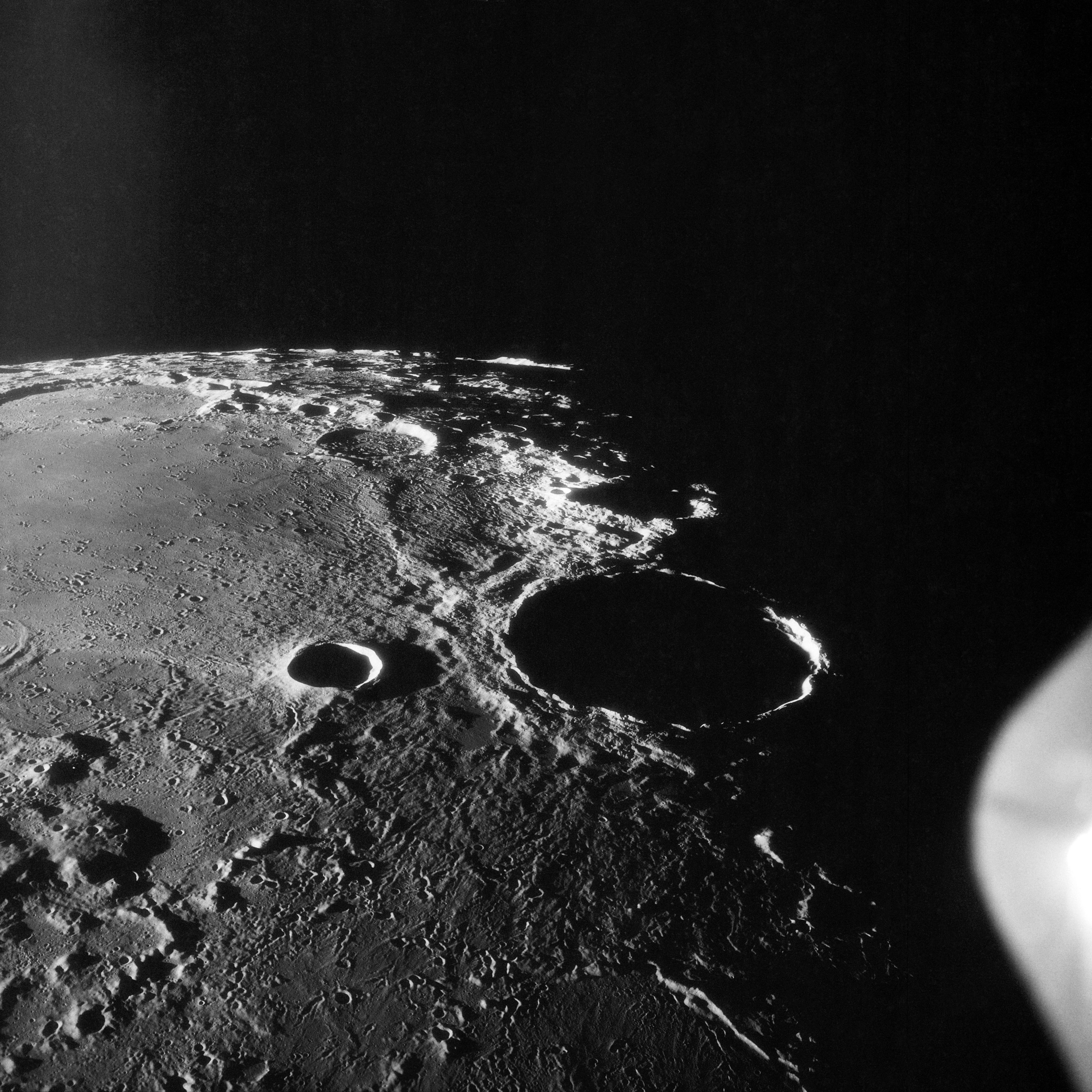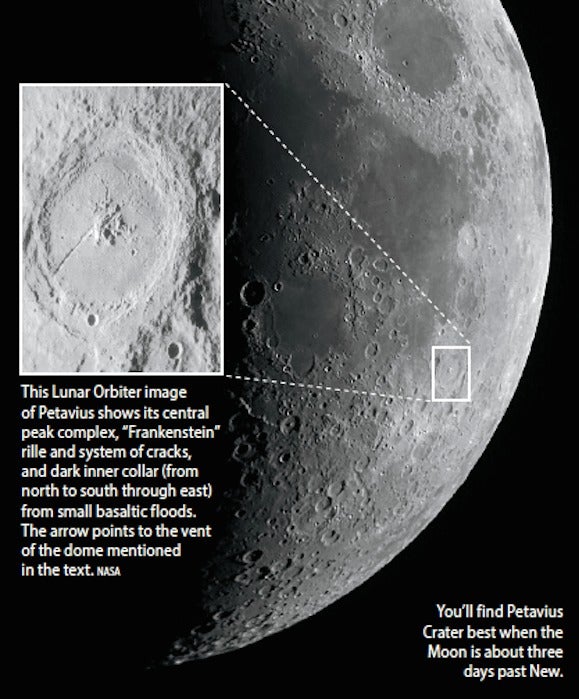
The following is an excerpt from Still As Bright: An Illuminating History of the Moon, from Antiquity to Tomorrow by Christopher Cokinos. The book will be published April 2, 2024, by Pegasus Books.
Actual seas, water, waves, and wave crests, there upon the surface of the primal Moon? Magma hissing on a watery beach, steam disappearing into whatever air that was? Oceans of water on the Moon? It might have been.
The originating magma ocean would have outgassed water, leading to a short-lived dense atmosphere. And, according to a 2018 study by Dirk Schulze-Makuch and Ian Crawford, it’s possible that the very, very early Moon then had a surface ocean of water that was more than three thousand feet deep. They admit that “this would be a very optimistic estimate . . . but it illustrates how much water might potentially have been available.”
Another possibility is that about 3.5 billion years ago—the Nectaris impact basin would have been visible from the Earth by then—outgassing from lava flows might have built up an atmosphere with enough pressure for surface waters to be maintained. But if this lava-flow outgassing alone were responsible for putative lunar rivers, lakes, or seas—and not from the magma ocean—then the lunar water volume would have been far less. Such a later watery Moon would have had a surface layer of only about three millimeters—just .1 inches. Less an ocean and more a sheen. Enough, though, to reflect Earthshine, sun-shine, starlight, the bursting colonnades of erupting fire fountains.
A 2016 study contends that the both the Moon and the Earth had a lot of water “from the start.” More recent research suggests that Theia’s origins were far out in the early solar system, and when it smashed into the proto-Earth, the impactor deposited tremendous amounts of water to what would become the new Earth and Moon.
Schulze-Makuch and Crawford wrote about early lunar water and atmospheres in an article that also was interested in life itself. The piece appeared in the journal Astrobiology with a provocative title: “Was There an Early Habitability Window for Earth’s Moon?” The piece is highly speculative. Deliciously so.

Building out their hypothesis from research showing that the Moon “is not as dry as previously thought,” including evidence for more water deep within, the scientists say that “associating our Moon with habitability seems outrageous,” but the lines of evidence for water and an atmosphere ages ago means they can “speculatively identify two possible windows for lunar habitability … immediately following the accretion of the Moon and some hundreds of millions of years later following outgassing associated with lunar volcanic activity.” In short, where there is water, there is indeed the chance for life. Lunar liquid water might have occurred on the surface and beneath, threading through rock fractures formed from the shocks of impacts. Researchers have long argued for impact craters and fissures as the likely sites of microbial evolution.
“Whether life ever arose on the Moon,” admit Schulze-Makuch and Crawford, “is of course highly speculative.”
At least three obstacles present themselves to the rise of lunar microbes, quite apart from the uncertainty about the amount of water present. First is whether a dense-enough atmosphere ever accumulated. A 2017 study led by Debra Needham points to a span of seventy million years in which, due to lava-flow outgassing, a perfectly respectable atmosphere could have taken hold. Before that, as the lunar magma ocean crystallized, an even thicker blanket of gasses could have swathed the Moon. (Crawford, now, however, is convinced by other work arguing for the unlikelihood of any lunar atmosphere at all. As well, if it existed, any surface evidence for lunar liquid water is long since gone.) Second, magnetic fields protect surfaces from dangerous solar and cosmic radiation. It’s unclear whether the Moon had a magnetic field of any consequence. It’s possible, as some have hypothesized, that the early Earth and Moon had a kind of overlapping field. Whatever the Moon was generating on its own wound down, since the lunar core is small and its rotation eventually gave up the ghost. Work by University of Rochester scientist John Tarduno suggests the Moon’s magnetic field, if it had one, was active from about 4.5 billion years ago—when it formed—then was a wisp of its former self within five hundred million years. What is clear is that a lot of magnetized Apollo samples are not relics of an early magnetic field, but rather were magnetized when impactors struck the Moon’s surface.
Finally, how quickly can nonliving chemistry transition—or flip—itself into life? We don’t know. If, as some argue, life can arise from its abiotic elements relatively quickly—within a few million years—then the Moon’s chances of having hosted life are better than we might have thought a few years ago. Recent work on the evolution of life on Earth suggests it may have originated as early as three hundred million years after the planet’s formation. Schulze-Makuch and Crawford also admit that “we do not know whether there were any intrinsic organic compounds on the Moon,” though they surely landed there from asteroid impacts. Moony microbes are a far cry from tall, rational Selenites or W.H. Pickering’s garden of Eratosthenes. But finding traces of early lunar life would be an astonishing development, suggesting life is commonplace in the universe.
Searching for evidence of such possible lunar life will be extraordinarily difficult and most scientists would say fruitless. But it could be done. First, drill down to the paleoregolith to look for signs of water or chemical biosig- natures or even fossils. Second, drill down to locate and study lunar samples for evidence of clays, which can only form in the presence of water. Finally, use “simulation chambers” to produce conditions akin to that of the early Moon to see what transpires.
Crawford tells me “the problem will be knowing where to look.” The other problem is just how hard it will be to drill that deep to obtain samples. It’s never been done. “My own view is that these kinds of investigations, and many others, may not be practical until a significant scientific infrastructure has been developed on the Moon,” he adds.
I could explain how sweet it felt one Tucson evening when I finally spied that little blister of a lunar dome in the southern end of the massive, variegated crater Petavius, how challenging this had been, because to see such a subtle feature one needs the terminator near, so the Sun casts its low light and because Petavius is one of several large craters on the waxing early crescent, so the Moon is usually too low to afford clear and steady views. So to see the volcano in Petavius was a thrill, the result of diligent looking and just-so circumstances and to know the volcano in Petavius is to know something of the story of how we have interpreted the surface of the Moon.

Meanwhile, Schulze-Makuch has been planning to run simulations of early lunar conditions—simulations put on hold when the COVID-19 pandemic hit—and, while he agrees with Crawford that we need to do the hard work on the Moon itself, such lab experiments can illuminate possibilities and parameters. “Personally, I see the Moon as most exciting as a possible repository for ancient life on Earth (e.g., in the south polar ices),” he tells me, “but I also believe that for some time—even if it was only geologically brief—a thin atmosphere might have been possible, and active life as well—but it was probably spatially very constrained and quite short in duration, nothing like a global microbial biosphere we had on Earth billions of years ago. As Ian pointed out, even if it existed, it will be very hard to find. But I still find the topic extremely exciting.”
So do I. Now I don’t have to time-travel to Pickering’s fictional living Moon. I can imagine lunar paleontologists working where my eye scans from Earth. The sound of passing traffic becomes instead the sound of hissing water.
When I look at the Moon I see a scumble of violence and change that I register as terrain and that my mind knows is time. Inside me, and on my bookshelves, is an archive that puts the Moon’s history in slow-motion. From the aged impacts beneath the lava plains—the gray vellum of Imbrium, Nubium, Australe, Nectaris—to the relatively recent white-rayed craters—Messier, Proclus, Kepler—I have a growing understanding of the seemingly changeless Moon as an artifact, in this recent era, of change, if extraordinarily slow by human standards. Now I can even imagine a vanished ocean and putative microbes. More and more, this understanding coexists in me, wordless if that makes sense, as I scroll across the visual precision of the Moon’s surface, a precision at once adrenal and palliative. I wish I could explain this to Coventry Patmore or my now-gone father.
There was a time when that shield volcano wasn’t there. Now it is. But the change I see is in the past, silent films of lunar violence whose coda appears complete. Apart from ever-shifting light on the lunar surface, what else moves? What if I were to see changes now? Not Pickering’s insect hordes or leafy tendrils. No, “just” a flash of light on a lava plain or a ruddy wisp of excited gasses sighing from a rille. A cloud. A mist. Some have said they’ve seen these and some still do. Some believed and some still do that the Moon is not so dead after all and that visual observers like me might detect some minute event. It’s rather unlikely but alluring, and this quest has a strange history.
Two of the believers, I’ve learned, were pioneering scientists in the early days of the Space Age, including a NASA astronomer who briefed astronauts before their journeys and who collected thousands of reports of what has come to be called “transient lunar phenomena.” Like these “TLP” themselves, Winifred Sawtell Cameron and Barbara Middlehurst have largely been ignored. But their stories are one of perseverance in the face of doubt and that era’s endemic sexism. Ever-controversial, TLP have gotten some renewed attention in the twenty-first century. As they do, it seems only right that two of its pioneers receive the same. Whether any TLP are finally proven to exist, the fascination they’ve held for centuries—and the forgotten endeavors of Middlehurst and Cameron—are inextricably part of the Moon’s personal and scientific saga.
Christopher Cokinos is the author or coeditor of several books, including The Fallen Sky: An Intimate History of Shooting Stars, Hope Is the Things with Feathers: A Personal Chronicle of Vanished Birds, and Beyond Earth’s Edge: The Poetry of Spaceflight. He is the winner of awards and fellowships from, among others, New American Press, the Whiting Foundation, the Rachel Carson Center in Munich, and the National Science Foundation. His poems, articles, and essays have appeared in such venues as Scientific American, High Country News, Astronomy, Discover.com, and the Los Angeles Times. Having taught literature, writing, and science communication for more than three decades at three universities, he again lives and writes in Utah. His website is www.christophercokinos.com.









